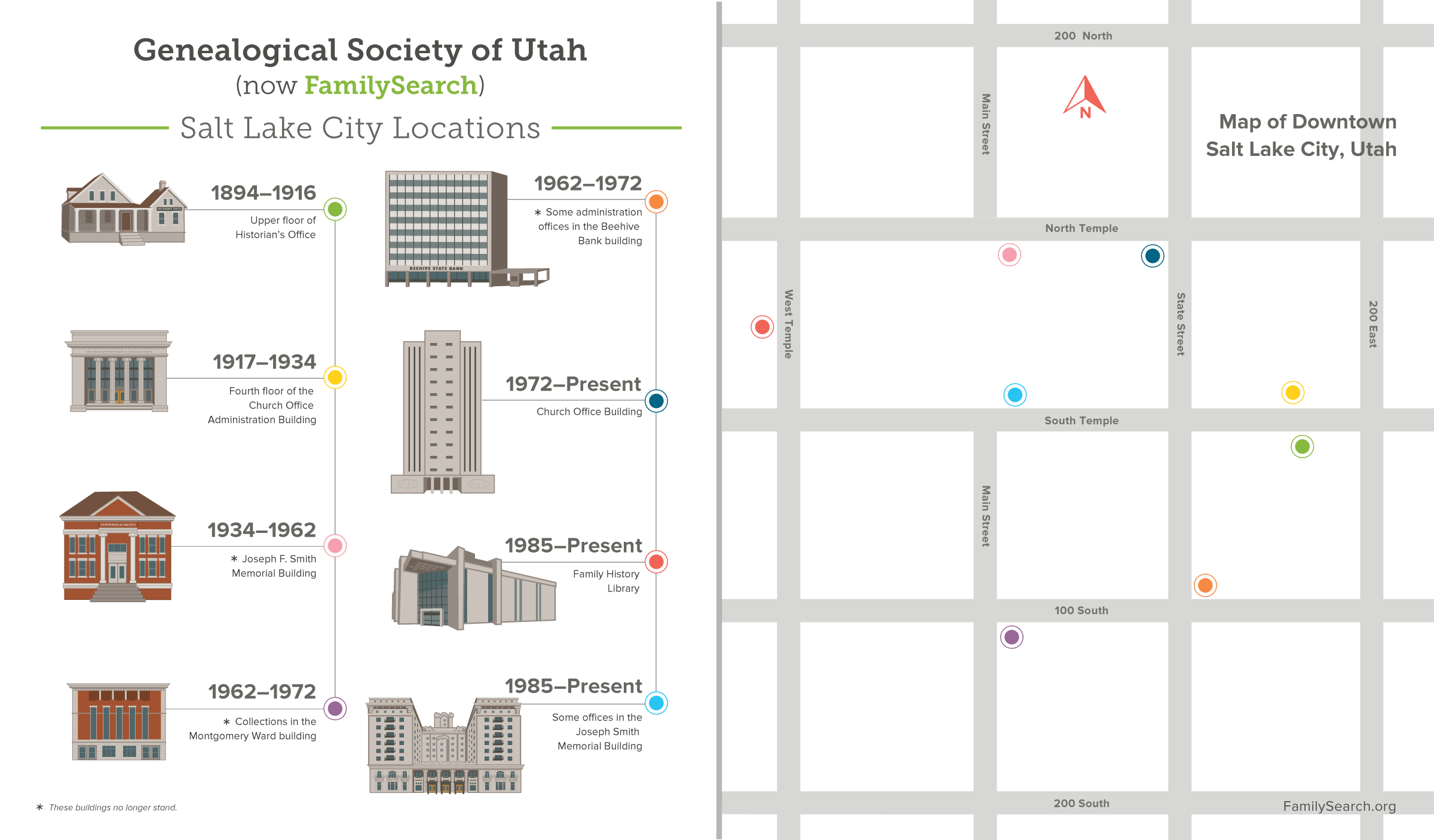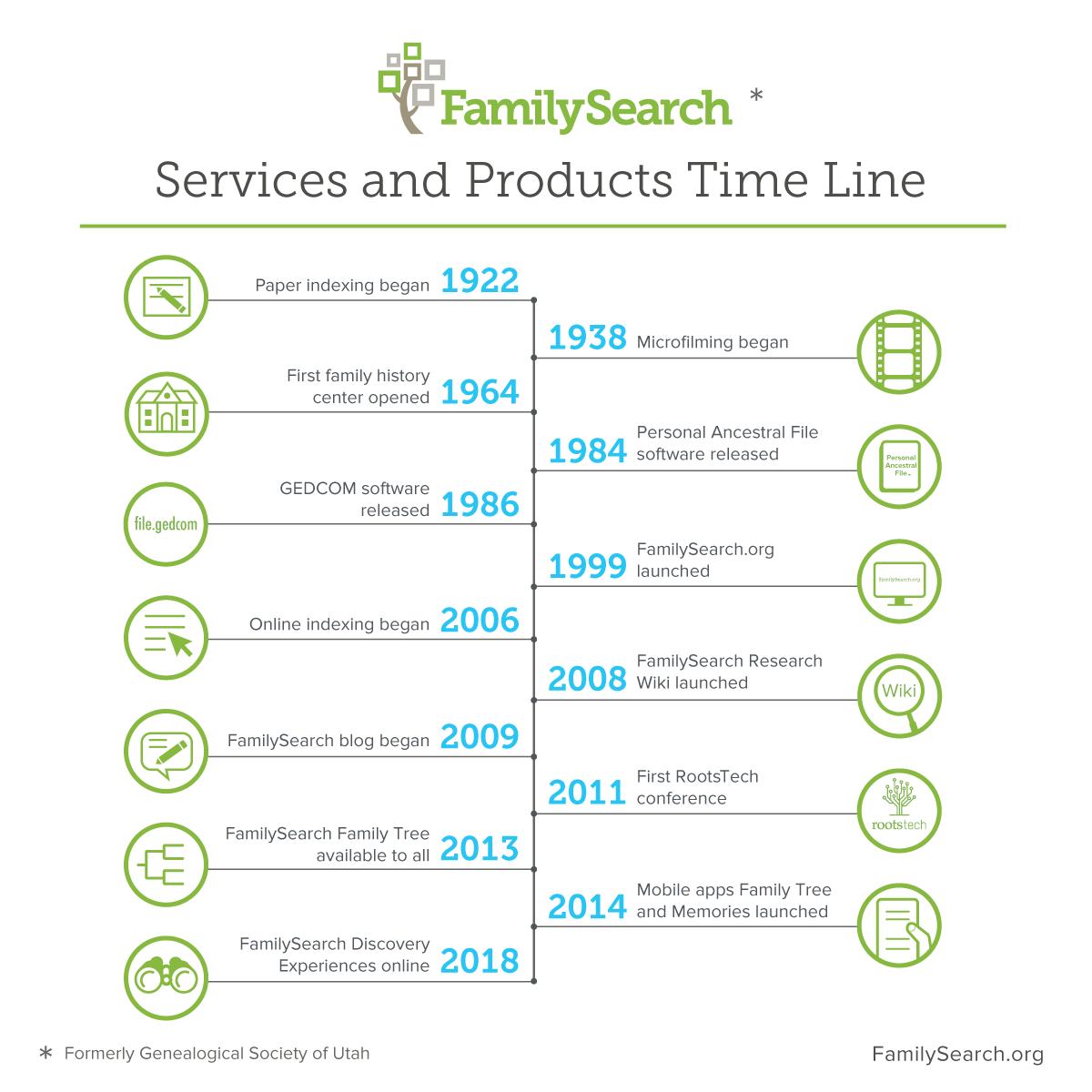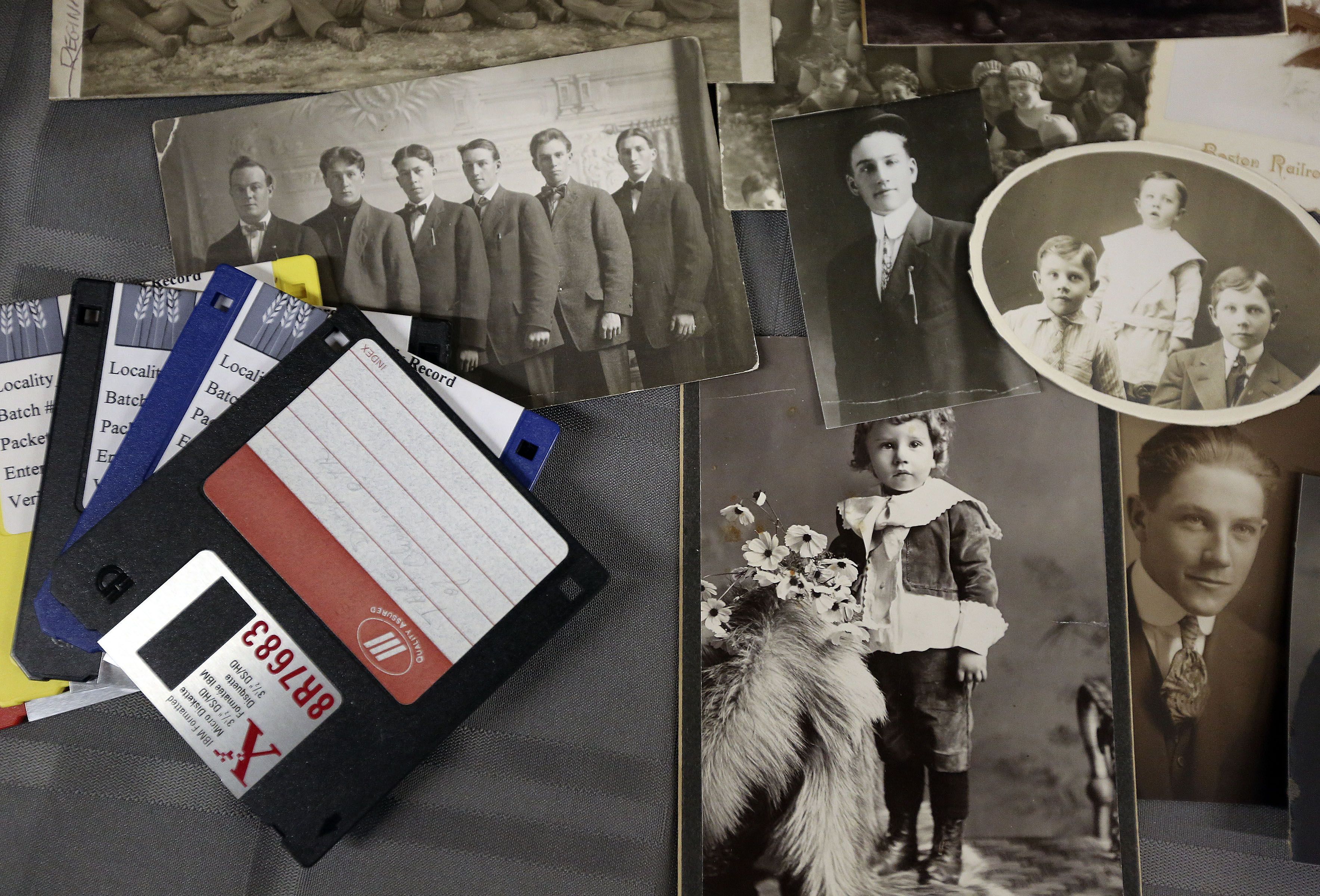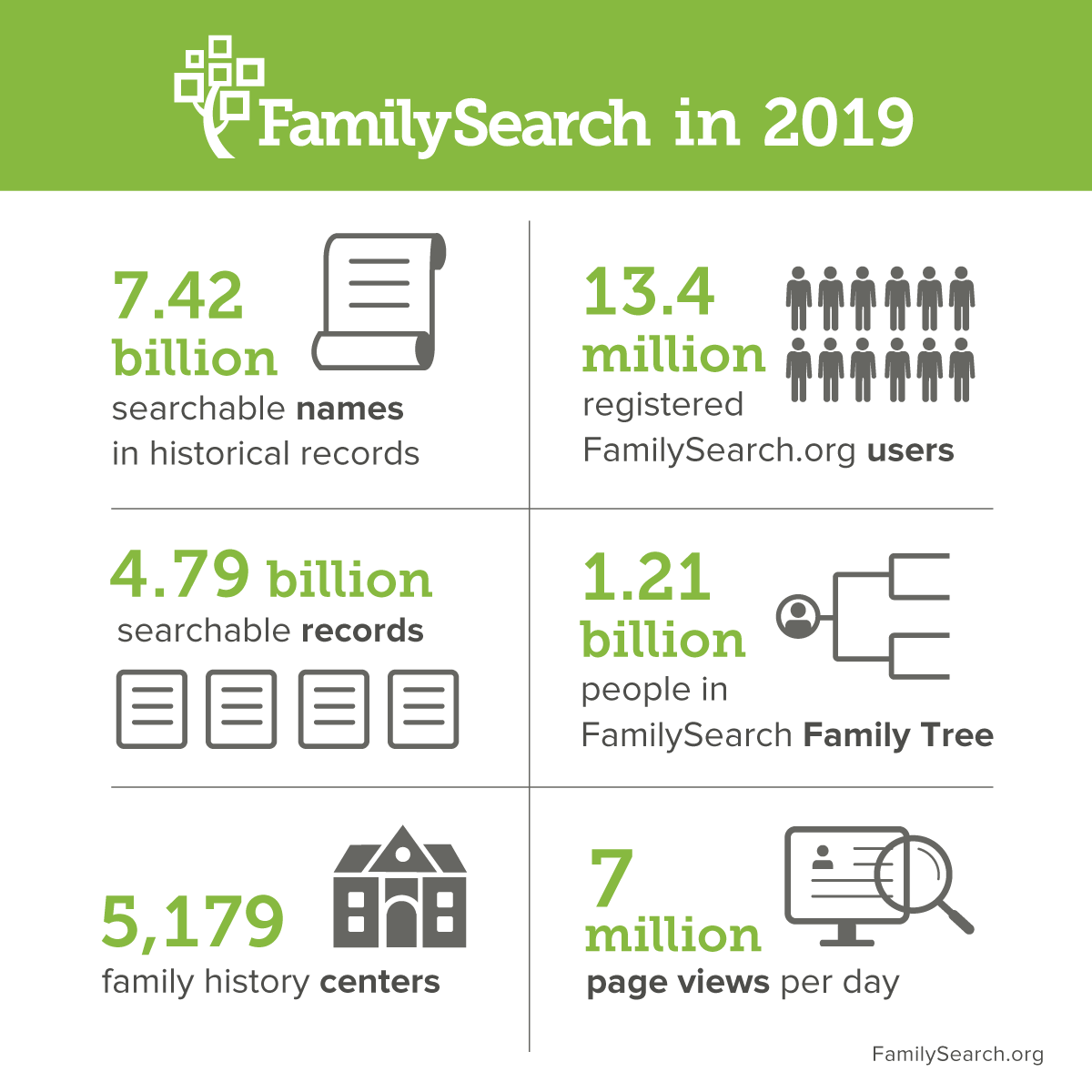Excerpts from the Church News Article: FamilySearch celebrates 125th anniversary — here’s how it has become the largest genealogy organization in the world and other sources.

FamilySearch celebrated the commencement of its 125th Anniversary on November 13.
Former and current Family History Department executive directors, assistant executive directors, managing directors, employees, missionaries and patrons gathered at the Family History Library in Salt Lake City to commemorate the 125th anniversary of the Genealogical Society of Utah — a milestone that epitomizes the growth of not only the organization but also the increasing interest of people worldwide in wanting to know more about their roots.
In an upstairs room of the Church Historian’s Office in Salt Lake City on Nov. 13, 1894, the Genealogical Society of Utah was established under the direction of Wilford Woodruff, the fourth president of The Church of Jesus Christ of Latter-day Saints.
Today, the Genealogical Society of Utah is known as FamilySearch International, and it stands as the largest genealogy organization in the world. Over the past 125 years, FamilySearch has worked to publish almost 4.8 billion searchable records and grow its family tree to more than 1.2 billion people.
“From a small, humble beginning in an upstairs room with 190 donated books 125 years ago, we today are moving forward at an ever accelerating pace,” said Elder Kevin S. Hamilton, executive director of the Family History Department, during an anniversary celebration on Wednesday, Nov. 13.

What began as a humble state family history society over a century ago, today has blossomed into a global organization that continues to help millions of people make inspiring family connections.
Elder Hamilton quoted President Russell M. Nelson at the Rome Italy Temple dedication when he said, “This is a hinge point in the history of the Church. Things are going to move forward at an accelerated pace. … The Church is going to have an unprecedented future, unparalleled. We’re just building up to what’s ahead now.”
The Power of Knowing Your Ancestral Roots
Discovering one’s family roots has morphed over the past 125 years. Millions of consumers are now using online genealogy services like FamilySearch to better understand who they are and to satisfy their curiosity regarding their heritage. Convenient access to innovative genealogical services like DNA testing, unsurpassed volumes of historical records online, and the proliferation of family history-related reality TV shows have no doubt fueled the boom of consumer interest in genealogy.
New York Times bestselling author, Bruce Feiler, reiterates this principle in his book “The Secrets of Happy Families”. He teaches that the most important thing you can do for your family is to develop strong family narratives or histories that help provide a sense of identity for family members through time. Personal stories and detailed family histories are powerful and important and need to be remembered and shared he says. A related Emery University study concluded that the more children know about their larger family, the better prepared they are to deal with life’s challenges.

The Beginning
In an interview with the Church News a week before the anniversary celebration, David Rencher, director of the Family History Library and chief genealogical officer of FamilySearch, commented on some of the historical background of the Genealogical Society of Utah.
One point is the connection to the Salt Lake Temple. About 18 months prior to the establishment of the Genealogical Society of Utah, President Woodruff dedicated the Salt Lake Temple on April 6, 1893. In the dedicatory prayer, President Woodruff asked the Lord to send the spirit of Elijah and increase the desire of the Saints to search out their ancestors.

“Over the next two decades after that prayer, there was a flurry of published family histories produced, particularly in New England, where many of the Saints had originated,” Rencher said. “And these published family histories yielded thousands of names of ancestors and family members of the Saints who are here in the valley.”
There were other factors that contributed to the establishment of a genealogical organization. At the time the Salt Lake Temple was dedicated, sealing ordinances were limited. In addition to husbands and wives being sealed to each other, and men and women being sealed by proxy to their deceased parents, it was a custom to be “adopted” into the family of a Church leader or other prominent priesthood holder.
In the April 1894 general conference, President Woodruff announced a change in policy: “Let every man be adopted to his father … not to any other man outside the lineage of his father.”
President Woodruff continued, “We want the Latter-day Saints from this time to trace their genealogies as far as they can, and to be sealed to their fathers and mothers. Have children sealed to their parents, and run this chain through as far as you can get it” (Hearts Turned to the Fathers: A History of the Genealogical Society of Utah, 1894-1994).
The new policy had a large impact on genealogical work as Latter-day Saints committed more fully to finding and organizing correct family records.
With the approval of the First Presidency and Quorum of the Twelve Apostles, the Genealogical Society of Utah was established in 1894. Franklin D. Richards, then a member of the Quorum of the Twelve Apostles, was the first president of the organization.
The organization began building its library with 190 donated volumes donated by Franklin D. Richards.

The goals of the organization were first, to establish and maintain a genealogical library for the use and benefit of anyone who was interested; second, disseminate genealogical information; and third, acquire records of the dead in order to perform ordinances on their behalf (Hearts Turned to the Fathers: A History of the Genealogical Society of Utah, 1894-1994).
Rapid Advancements
Many notable advancements over the next century allowed the Genealogical Society of Utah to expand, Rencher explained. Paper indexing began in 1922. In 1924, the Genealogical Research Bureau was established to help in several languages. The Temple Index Bureau was created in 1927 to coordinate efforts and prevent duplication.
Microfilming began in 1938. “Suddenly, that completely changed the landscape for us,” Rencher said. “Not only we didn’t have to depend on just what was published… now we could actually start to look at images of original records.”

In 1963, the Granite Mountain Records Vault was built to store microfilm. With the opening of the first branch libraries in 1964, now known as family history centers, those images could be disseminated. Today, more than 5,000 family history centers are found in 129 countries.
The Personal Ancestral File software was released in 1984, allowing patrons to record information on a personal computer.
“We went from microfiche to compact discs to computer programs to personal desktop organizations. We went through that whole succession of very rapid transition,” Rencher said.
As part of an effort to simplify ancestral research and encourage members to perform temple ordinances for their ancestors, the Genealogical Department of the Church was renamed to be the Family History Department in 1987.

President Boyd K. Packer, a member of the Quorum of the Twelve Apostles who died in 2015, was chairman of the Temple and Family History Executive Council when the name change occurred. He said, “The word genealogy often suggests a need for professional training and the change to ‘family history’ will make the work less technical and more appealing to members of the Church.
“A genealogy is, in fact, a family history,” then-Elder Packer continued, “and such sacred family history is fundamental to the temple ordinances and covenants that bless individuals and seal them into eternal families” (Ensign, October 1987).
There was no change in the name of the Genealogical Society of Utah at that time, but a new and upcoming website would soon spark a name change to the organization.
With the launch of a website, the Family History Department needed a “handle” that would be “definitive of our online presence,” Rencher said. In 1999, FamilySearch.org was launched. The Genealogical Society of Utah was later renamed in 2005 to “FamilySearch” to better fit the description of what the organization does and what it offers.

Future
Elder Hamilton commented on the future of FamilySearch during the anniversary celebration. He mentioned the interest in computer-assisted indexing, machine learning and artificial intelligence to speed up the indexing process. He also said FamilySearch is beginning to look at the potential of using computer-assisted tree building.
“We’re just beginning our strategy for DNA research and DNA utilization,” he added. “The technology is new and we do not yet completely understand how this all works. But the potential is there for us to reconstruct the family tree of humankind using DNA.”
Elder Hamilton said FamilySearch will continue to strive to engage, entice and encourage all of Heavenly Father’s children to participate in the work of salvation.
For more details you can read the full article from Church news: FamilySearch celebrates 125th anniversary — here’s how it has become the largest genealogy organization in the world
